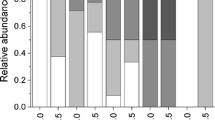Abstract
The population dynamics and reproductive biology of an ascidian- and a sponge-dwelling amphipod were examined. The two undescribed amphipod species, Leucothoe“ascidicola” and L.“spongicola”, are closely related to each other, and occur in ascidians and sponges, respectively, along the Florida Atlantic coast. L. “ascidicola” was abundant in solitary ascidians during fall 1997, disappeared during spring/early summer, and became abundant again in September 1998. During the time when L. “ascidicola” were absent from their hosts, a copepod became a frequent inhabitant of the ascidians but disappeared again when L.“ascidicola” returned to the ascidians in September 1998. The numbers of L.“spongicola” in sponges increased substantially during spring, when high reproductive activity was observed. Following this reproductive peak, both adult and juvenile amphipods apparently left the sponges, and during the summer amphipod numbers in the sponges were very low. Another small amphipod species, which often co-occurred with L.“spongicola”, showed less seasonal variation and was found in sponges throughout the whole study period. The percentage of ovigerous females per host unit was usually lower in the ascidian-dwelling than in the sponge-dwelling amphipods. In solitary ascidians, L.“ascidicola” amphipods usually occurred in groups of several adults, yet there never was more than one ovigerous female per ascidian. In contrast, several ovigerous L.“spongicola” females were found to cohabit in the same spongocoel. This suggests that intrasexual aggression may be stronger among reproductive amphipod females in the ascidians than in sponges. The size distributions of juvenile cohorts indicate that juvenile L.“ascidicola” remain for relatively long time periods in the parental ascidian, where they may reach sexual maturity. In contrast, in L.“spongicola”, only cohorts of very small juveniles could be identified, indicating that juveniles disperse shortly after emerging from the female's brood pouch. It is concluded that extended parental care is of very short duration or does not occur in the sponge-dwelling amphipod L. “spongicola”, possibly because fast-growing sponges with a highly branched spongocoel system do not allow long-lasting coexistence of parent-offspring groups. In contrast, the discrete character of the solitary ascidians may enhance the potential for exclusion of other species, resource monopolization by reproductive females, and furthermore for long-lasting extended parental care in the ascidian-dwelling amphipod. Groups of single parents together with cohorts of large juveniles are reported in the literature for amphipods and isopods from brachiopods, bivalves and ascidians, suggesting that these discrete biotic microhabitats may favor the evolution of extended parental care in peracarid crustaceans.
Similar content being viewed by others
Author information
Authors and Affiliations
Additional information
Received: 30 July 1999 / Accepted: 8 May 2000
Rights and permissions
About this article
Cite this article
Thiel, M. Population and reproductive biology of two sibling amphipod species from ascidians and sponges. Marine Biology 137, 661–674 (2000). https://doi.org/10.1007/s002270000372
Issue Date:
DOI: https://doi.org/10.1007/s002270000372




